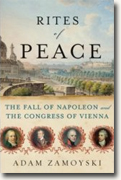Rites of Peace
Adam Zamoyski
book reviews:
· general fiction
· chick lit/romance
· sci-fi/fantasy
· graphic novels
· nonfiction
· audio books
· author interviews
· children's books @
curledupkids.com
· DVD reviews @
curledupdvd.com
newsletter
win books
buy online
links
home
for authors
& publishers
for reviewers

 |
Rites of Peace: The Fall of Napoleon and the Congress of Vienna Adam Zamoyski HarperCollins Hardcover 656 pages July 2007 |
|
Adam Zamoyski is rapidly becoming one of my favorite Napoleonic era historians. His Moscow 1812 was brilliant, well-researched, and extremely detailed, and his Rites of Peace: The Fall of Napoleon and the Congress of Vienna
Zamoyski saves his greatest detail for the Congress of Vienna. Opening in early November, 1814, this Congress (which Metternich estimated would last about six weeks) lasted upwards of six months. Ostensibly, it was supposed to solve all of Europeís pressing problems, but it turned into more of a social occasion; negotiations often dragged on to great lengths to solve small issues. Zamoyski spends an incredible amount of time on the sexual escapades and romantic dalliances of the attendees, from the Russian Tsar to Metternich and Talleyrand of France. There were balls, dances, and performances almost every night, and times when negotiators (especially Metternich) spent more time worrying about their personal affairs than about what they were negotiating at the table. Zamoyski is able to provide this detail because Metternich had the Austrian police keep close tabs on every delegate, and the police reports are extensive. Of course, it wasnít all social occasions. The Congress of Vienna consisted of a great deal of horse-trading between the powers, each side trying desperately to get the deal that would most favor them, often at odds with other European powers. Zamoyski does a great job showing what each faction wanted and how it contrasted with othersí plans. Alexander wanted to demonstrate that Russia was the preeminent power in Europe. Prussia wanted to assume control of vast swaths of German land. Metternich and Austria wanted to curtail, as much as possible, Russiaís power and influence. Almost every province or duchy in Europe, in addition to the great powers themselves, had representatives at the Congress, all of them looking to get a piece of the action. Zamoyski makes all of this fascinating, as we see all the conflicts that arose from these negotiations. Unfortunately, Rites of Peace This is countered, however, by Zamoyskiís readable writing style. While dry at times, for the most part his prose keeps you reading (though perhaps in small chunks). Rites of Peace Rites of Peace All in all, Rites of Peace Originally published on Curled Up With A Good Book at www.curledup.com. © Dave Roy, 2007 |
| Also by Adam Zamoyski: |
|
|
|
 Click here to learn more about this month's sponsor! |
|
| fiction · sf/f · comic books · nonfiction · audio newsletter · free book contest · buy books online review index · links · · authors & publishers reviewers |
|
| site by ELBO Computing Resources, Inc. | |
 Once again, Zamoyski doesnít dwell on the military details of battles, though he certainly doesnít gloss over them, either. Readers wishing for in-depth examinations of the battles of Liepzig or Waterloo will be left wanting. Instead,
Once again, Zamoyski doesnít dwell on the military details of battles, though he certainly doesnít gloss over them, either. Readers wishing for in-depth examinations of the battles of Liepzig or Waterloo will be left wanting. Instead,